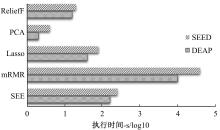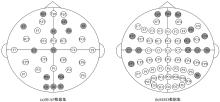Journal of Jilin University(Engineering and Technology Edition) ›› 2022, Vol. 52 ›› Issue (8): 1834-1841.doi: 10.13229/j.cnki.jdxbgxb20210115
SEE: sense EEG⁃based emotion algorithm via three⁃step feature selection strategy
Feng-feng ZHOU1,2( ),Hai-yang ZHU1,2
),Hai-yang ZHU1,2
- 1.College of Computer Science and Technology,Jilin University,Changchun 130012,China
2.Key Laboratory of Symbolic Computation and Knowledge Engineering of Ministry of Education,Jilin University,Changchun 130012,China
CLC Number:
- TP391
| 1 | Fraschini M, Meli M, Demuru M, et al. EEG fingerprints under naturalistic viewing using a portable device[J]. Sensors, 2020, 20(22): 20226565. |
| 2 | 方明, 陈文强. 结合残差网络及目标掩膜的人脸微表情识别[J]. 吉林大学学报: 工学版, 2021, 51(1): 303-313. |
| Fang Ming, Chen Wen-qiang. Face micro-expression recognition based on ResNet with object mask[J]. Journal of Jilin University(Engineering and Technology Edition), 2021, 51(1): 303-313. | |
| 3 | Li X, Song D, Zhang P, et al. Exploring EEG features in cross-subject emotion recognition[J]. Frontiers in Neuroscience, 2018, 12(1): 162-176. |
| 4 | 代琨, 于宏毅, 仇文博, 等. 基于SVM的网络数据无监督特征选择算法[J]. 吉林大学学报: 工学版, 2015, 45(2): 576-582. |
| Dai Kun, Yu Hong-yi, Qiu Wen-bo, et al. Unsupervised feature selection algorithm based on support vector machine for network data[J]. Journal of Jilin University(Engineering and Technology Edition), 2015, 45(2): 576-582. | |
| 5 | Gupta V, Chopda M D, Pachori R B. Cross-subject emotion recognition using flexible analytic wavelet transform from EEG signals[J]. IEEE Sensors Journal, 2019, 19(6): 2266-2274. |
| 6 | Duan R N, Zhu J Y, Lu B L. Differential entropy feature for EEG-based emotion classification[C]∥6th International IEEE/EMBS Conference on Neural Engineering, San Diego, USA, 2013: 81-84. |
| 7 | Zheng W L, Lu B L. Investigating critical frequency bands and channels for EEG-based emotion recognition with deep neural networks[J]. IEEE Transactions on Autonomous Mental Development, 2015, 7(3): 162-175. |
| 8 | Zhang J H, Chen M, Zhao S K, et al. Relieff-based EEG sensor selection methods for emotion recognition[J]. Sensors, 2016, 16(10): 1558-1572. |
| 9 | 周怡娜, 董宏丽, 张勇, 等. 基于VMD去噪和散布熵的管道信号特征提取方法[J]. 吉林大学学报: 工学版, 2022, 52(4): 959-969. |
| Zhou Yi-na, Dong Hong-li, Zhang Yong, et al. Feature extraction method of pipeline signals based on VMD de-noising and dispersion entropy[J]. Journal of Jilin University(Engineering and Technology Edition), 2022, 52(4): 959-969. | |
| 10 | Yang S, Li B, Zhang Y, et al. Selection of features for patient-independent detection of seizure events using scalp EEG signals[J]. Computers in Biology and Medicine, 2020, 119: 103671. |
| 11 | 张冠华, 余旻婧, 陈果, 等. 面向情绪识别的脑电特征研究综述[J]. 中国科学: 信息科学, 2019, 49(9):1097-1118. |
| Zhang Guan-hua, Yu Min-jing, Chen Guo, et al. A review of EEG features for emotion recognition[J]. SCIENTIA SINICA Informationis, 2019, 49(9): 1097-1118. | |
| 12 | Koelstra S, Muhl C, Soleymani M, et al. DEAP: a database for emotion analysis; using physiological signals[J]. IEEE Transactions on Affective Computing, 2012, 3(1): 18-31. |
| 13 | Arnau-Gonzalez P, Arevalillo-Herraez M, Ramzan N. Fusing highly dimensional energy and connectivity features to identify affective states from EEG signals[J]. Neurocomputing, 2017, 244: 81-89. |
| 14 | Yang B, Han X, Tang J. Three class emotions recognition based on deep learning using staked autoencoder[C]∥10th International Congress on Image and Signal Processing, BioMedical Engineering and Informatics, Shanghai, China, 2017: 1-5. |
| 15 | Wu X, Zheng W L, Lu B L. Identifying functional brain connectivity patterns for EEG-based emotion recognition[C]∥9th International IEEE/EMBS Conference on Neural Engineering, San Francisco, USA, 2019: 235-238. |
| 16 | Zhang W, Wang F, Jiang Y, et al. Cross-subject EEG-Based emotion recognition with deep domain confusion[C]∥International Conference on Intelligent Robotics and Applications, Shenyang, China, 2019: 558-570. |
| 17 | Sarlo M, Buodo G, Poli S, et al. Changes in EEG alpha power to different disgust elicitors: the specificity of mutilations[J]. Neuroscience Letters, 2005, 382(3): 291-296. |
| 18 | Li M, Lu B L. Emotion classification based on gamma-band EEG[C]∥Annual International Conference of the IEEE Engineering in Medicine and Biology Society, Minneapolis, USA, 2009: 1223-1226. |
| 19 | Saarimki H, Gotsopoulos A, Jskelinen I P, et al. Discrete neural signatures of basic emotions[J]. Cerebral Cortex, 2015, 26(6): 2563-2573. |
| 20 | Lin Y P, Yang Y H, Jung T P. Fusion of electroencephalographic dynamics and musical contents for estimating emotional responses in music listening[J]. Frontiers in Neuroscience, 2014, 8: 94-107. |
| [1] | Feng-feng ZHOU,Yi-chi ZHANG. Unsupervised feature engineering algorithm BioSAE based on sparse autoencoder [J]. Journal of Jilin University(Engineering and Technology Edition), 2022, 52(7): 1645-1656. |
| [2] | Bin WANG,Bing-hui HE,Na LIN,Wei WANG,Tian-yang LI. Tea plantation remote sensing extraction based on random forest feature selection [J]. Journal of Jilin University(Engineering and Technology Edition), 2022, 52(7): 1719-1732. |
| [3] | Jun WANG,Yan-hui XU,Li LI. Data fusion privacy protection method with low energy consumption and integrity verification [J]. Journal of Jilin University(Engineering and Technology Edition), 2022, 52(7): 1657-1665. |
| [4] | Sheng-sheng WANG,Lin-yan JIANG,Yong-bo YANG. Transfer learning of medical image segmentation based on optimal transport feature selection [J]. Journal of Jilin University(Engineering and Technology Edition), 2022, 52(7): 1626-1638. |
| [5] | Yao-long KANG,Li-lu FENG,Jing-an ZHANG,Fu CHEN. Outlier mining algorithm for high dimensional categorical data streams based on spectral clustering [J]. Journal of Jilin University(Engineering and Technology Edition), 2022, 52(6): 1422-1427. |
| [6] | Wen-jun WANG,Yin-feng YU. Automatic completion algorithm for missing links in nowledge graph considering data sparsity [J]. Journal of Jilin University(Engineering and Technology Edition), 2022, 52(6): 1428-1433. |
| [7] | Xue-yun CHEN,Xue-yu BEI,Qu YAO,Xin JIN. Pedestrian segmentation and detection in multi-scene based on G-UNet [J]. Journal of Jilin University(Engineering and Technology Edition), 2022, 52(4): 925-933. |
| [8] | Shi-min FANG. Multiple source data selective integration algorithm based on frequent pattern tree [J]. Journal of Jilin University(Engineering and Technology Edition), 2022, 52(4): 885-890. |
| [9] | Da-xiang LI,Meng-si CHEN,Ying LIU. Spontaneous micro-expression recognition based on STA-LSTM [J]. Journal of Jilin University(Engineering and Technology Edition), 2022, 52(4): 897-909. |
| [10] | Xiao-hui WEI,Yan-wei MIAO,Xing-wang WANG. Rhombus sketch: adaptive and more accurate sketch for streaming data [J]. Journal of Jilin University(Engineering and Technology Edition), 2022, 52(4): 874-884. |
| [11] | Ming LIU,Yu-hang YANG,Song-lin ZOU,Zhi-cheng XIAO,Yong-gang ZHANG. Application of enhanced edge detection image algorithm in multi-book recognition [J]. Journal of Jilin University(Engineering and Technology Edition), 2022, 52(4): 891-896. |
| [12] | Lin MAO,Feng-zhi REN,Da-wei YANG,Ru-bo ZHANG. Two⁃way feature pyramid network for panoptic segmentation [J]. Journal of Jilin University(Engineering and Technology Edition), 2022, 52(3): 657-665. |
| [13] | Xue WANG,Zhan-shan LI,Ying-da LYU. Medical image segmentation based on multi⁃scale context⁃aware and semantic adaptor [J]. Journal of Jilin University(Engineering and Technology Edition), 2022, 52(3): 640-647. |
| [14] | Ji-hong OUYANG,Ze-qi GUO,Si-guang LIU. Dual⁃branch hybrid attention decision net for diabetic retinopathy classification [J]. Journal of Jilin University(Engineering and Technology Edition), 2022, 52(3): 648-656. |
| [15] | Xue-zhi WANG,Qing-liang LI,Wen-hui LI. Spatio⁃temporal model of soil moisture prediction integrated with transfer learning [J]. Journal of Jilin University(Engineering and Technology Edition), 2022, 52(3): 675-683. |
|
||







